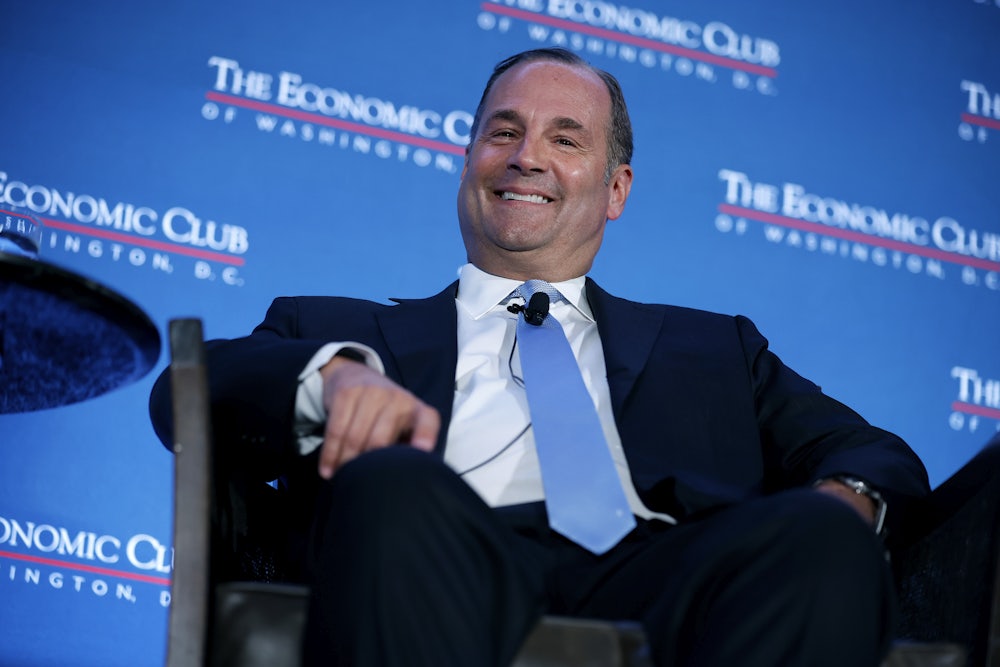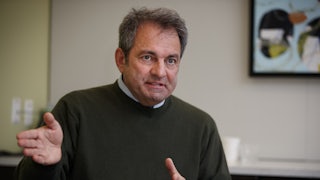Have you looked at your 401(k) recently? Probably it’s best not to. The S&P 500 index dropped 19 percent last year, the biggest decline since 2008, that fateful year when the subprime mortgage crisis almost caused a global depression.
In 2022, by comparison, the stock market fell even though the larger economy was in good shape. This was a reversal of the Covid spring of 2020, when the economy went into the toilet yet corporate profits zoomed upward. In 2022 the economy recovered briskly and it was corporate profits that fell, especially in the tech sector. The Covid pandemic was receding, making people less dependent on web services, and Mark Zuckerberg’s crusade to lead humanity into the metaverse flopped. The cost of labor rose, and so did interest rates, diminishing capital investment. All the S&P 500 could think to do in response was increase stock buybacks, which for the first time exceeded $1 trillion. The stock market tanked anyway.
Were corporate executives held to account for this declining performance? You might as well ask whether pigs can fly. As I noted in October, between January 1978 and January 2021, growth in CEO compensation outpaced growth in the S&P 500. If you could invest in chief executives, you’d get a better return than you can by investing in the companies they run.
This past weekend, the Financial Times’ Patrick Temple-West published the findings of ISS Corporate Solutions, or ICS, a consulting firm that specializes in executive compensation and corporate governance, concerning CEO pay in 2022. ICS found that even in that god-awful year for the stock market, more than one-third of the S&P 500 companies with proxy statements filed as of April 14—that’s about 60 percent of them—gave top executives a raise, even though shareholder returns in these same companies declined. Only about one-quarter of this sample cut CEO pay. In plain English, S&P 500 companies were this year more likely to reward rather than punish chief executives for their companies’ lousy stock performance.
The largest shopping center owner in the United States is Simon Properties. It owns the Beverly Center in Los Angeles and the Dolphin Mall in Miami. According to The Motley Fool, over the past year, its returns fell 15.89 percent while the S&P 500 fell 5.80 percent. Over the past five years, Simon Properties’ returns fell 29.11 percent while the S&P rose 55.77 percent. In calendar year 2022, Temple-West reports, Simon Properties’ shareholder return dropped 22 percent.
Not a great business, shopping malls, even before Covid. I walked past one the other day in Northwest Washington. It had a big sign that said, “Anchor Opportunity,” which are just about the saddest two words I ever saw. So it’s no surprise that Simon Properties is struggling. The chief executive, one David Simon, is the son of Melvin Simon, who, along with David’s Uncle Herbert, co-founded Simon Properties back in 1960. David must feel awfully discouraged these days about the family legacy. But my sympathy evaporated when I read, in Temple-West’s story, that the Simon Properties board decided to cheer David up last year by tripling his compensation to $35.7 million.
Another chief executive cited in the Financial Times piece is Anthony Capuano, CEO of Marriott. The rare S&P 500 company founded in Washington, D.C., Marriott began in the 1920s as a root beer stand, evolved into the Hot Shoppes restaurant chain (a sort of poor man’s Howard Johnson’s), and then, in the late 1950s, became a hotel chain. Hotels, unlike malls, are making a strong comeback, but they still aren’t back to where they were before Covid. Over the past year, according to The Motley Fool, Marriott returns dropped 6.87 percent, or just a bit faster than the S&P 500. Over the past five years Marriott returns have grown, but only at about half the rate of the S&P 500. In 2022, Temple-West reports, Marriott returns dropped 9.3 percent.
Marriott stock didn’t perform as badly as Simon Properties, but its shareholder returns were down. Yet Capuano’s pay rose 1.6 percent, to $18.7 million.
A Marriott spokesman advised Temple-West that a better measure of Capuano’s compensation is “compensation actually paid,” or CAP, which takes into account any decline in the value of stock previously awarded. Under the 2010 Dodd-Frank law, the SEC requires major corporations to disclose CAP for chief executives and to compare that to shareholder return. This was the first year that regulatory requirement was in place, and we won’t have a final tally for a month or so. It won’t be as dramatic as the FT’s findings. Because executive compensation draws heavily on stock awards, CAP will minimize CEO pay in a down market and exaggerate CEO pay in an up market. In Capuano’s case, Capuano’s compensation is down 27 percent for 2022, or nearly three times the hit to stockholders. Marriott is flagging Capuano’s CAP because it makes him look like he’s taking one for the team. But when the stock market recovers, Marriott will likely shift to criticizing the flaws in CAP methodology.
Another requirement in Dodd-Frank was “say on pay,” in which shareholders were given the opportunity to call a vote when they think executive pay is too high at a publicly traded corporation. The corporation in question isn’t required to do anything when it loses a say-on-pay vote, as it usually does, but the symbolic veto creates bad publicity. Last year saw the greatest number of say-on-pay vetoes—86—since they were initiated in 2011. The previous record of 71 was set the previous year, in 2021. For S&P 500 companies, 2022 saw a record 22 vetoes in 2022, topping the previous year’s record of 21. As You Sow, a shareholders’ rights nonprofit, has compiled a handy list of the S&P 500 companies with the most say-on-pay vetoes. Repeat offenders include Warner Brothers Discovery Inc., Netflix, Alphabet (Google), and Coca-Cola.
Corporations love to say the shareholder is king, but not where executive compensation is concerned. Shareholders couldn’t be clearer: They think CEO pay is out of control. This isn’t an offense just to lefty egalitarians. It’s an offense to old-school market capitalists too. Yet the problem only gets worse. It’s going to take a lot more say-on-pay vetoes to force a change. Twenty-two vetoes for S&P 500 companies may set a record, but it’s still only 4.4 percent. The dissidents need to get that figure closer to 60 percent. When shareholders for most of the nation’s biggest corporations are on record saying their chief executives are overpaid, maybe that will get the boardrooms’ attention.






